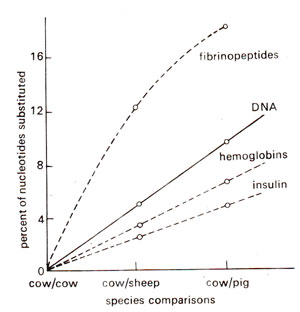
Fig. 48.3. Phylogenetic relationship of cow with sheep and pig, based on differences in nucleotide sequences deduced from DNA hybridization (solid line) and from amino acid analyses of three proteins (broken lines) (redrawn from McCarthy and Farqhar, Brookhaven Symp. Biol. 23, 1972).
Direct comparisons between the primary structures of nucleic acids can not be made since except for very small viruses like MS2 or Φ X 174. complete nucleotide sequences of whole genome are still not known for any organism. Indirect methods, involving
in vitro hybridization between nucleic acids extracted from different organisms, were utilized for the purpose.
McCarthy (1972) and others showed that for each 1% difference in the nucleotide sequences of the two organisms, say X and Y, the thermal stability (measured by melting point at which hybrid double stranded DNA dissociates into single stranded) of the X-Y hybrid DNA molecule is lowered by 1.6°C. In an experiment, nonrepetitive or 'unique' sequences of cattle DNA were hybridized with those of sheep and pig. The reduction in thermal stability was observed to be 6°C (3.7% mismatching) between cow/sheep hybrid, and 12°C (7.5% mismatching) between cow/pig hybrid, showing thus, a more significant evolutionary distance between cow and pig than between cow and sheep. It can also be seen that the rate of nucleotide substitutions in DNA as estimated by DNA hybridization was higher than the rate of amino acid substitutions occurring in haemoglobin and insulin and lesser than the amino acid substitutions in fibrinopeptides (as estimated by amino acid analysis). This clearly indicates that different portions of non-repetitive DNA can change at different rates and some portion of this DNA may not even code for proteins (Fig. 48.3). Many of the phylogenetic relationships determined by other taxonomic methods are reflected in the evolutionary relationships between species as determined broadly by DNA-DNA comparisons. However, to get more precise information regarding the nucleotide substitutions during evolution, it would be necessary for one to know the exact nucleotide mutation rates (called
evolutionary clock by some) and exact proportions of these mutations undergoing selections.

Fig. 48.3. Phylogenetic relationship of cow with sheep and pig, based on differences in nucleotide sequences deduced from DNA hybridization (solid line) and from amino acid analyses of three proteins (broken lines) (redrawn from McCarthy and Farqhar, Brookhaven Symp. Biol. 23, 1972).
Molecular evolution in test tube
Progress of evolution at molecular level, could also be studied in the test tube. In one such experiment enzymatic evolution of a protein could be shown in a
E. coli strain carrying a deletion for β galactosidase Z gene, and grown in lactose rich medium. These deficient
Zdel colonies started utilizing lactose within one month of growth, giving white coloured colonies (normal Z gene gives blue colonies; see
Genetic Engineering and Biotechnology 1. Recombinant DNA and PCR (Cloning and Amplification of DNA)). Further growth and selection gave rise to more efficient strains and finally, bacterial strain called Ebg (Solved β galactosidase) could be selected, which could form colonies as rapidly as wild type
E. coli. Various tests, however, showed that the new lactose-hydrolyzing enzyme was completely different from β galactosidase and had higher molecular weight, different immunological properties and sensitivity to different ionic conditions besides having a different genetic locus on the
E. coli map. These experiments, therefore, demonstrated that a protein, with only vague affinity for a particular function, can assume that function with efficiency by a stepwise evolutionary process of mutation and selection.
In another experiment, a Qβ RNA viral molecule was used. This is the smallest self-replicating molecule known so far, and has about 3600 nucleotides. It could replicate
in vitro upon addition of replicase enzyme and various ribonucleoside triphosphates. They practiced selection for rapid replication by successive transfers of only the earliest replicating molecules to new cultures. The genes for coat proteins and replicase enzyme were now unnecessary under these conditions. The successful Q(3 molecules now retained only the portion needed for recognition by replicase enzyme, and not those for its synthesis. Now intensive selection was done for a molecule which can replicate when only a single stranded molecule is present in the culture. This single stranded molecule or 'plus' strand must rapidly attract a replicase enzyme to form a complement (or 'minus' strand) which then forms a new plus strand and so on. Self-replicating RNA molecule called Midivariant-1 (MDV-1) of a length of 218 nucleotides was isolated by Spiegelman group by exercising these selection mechanisms.






